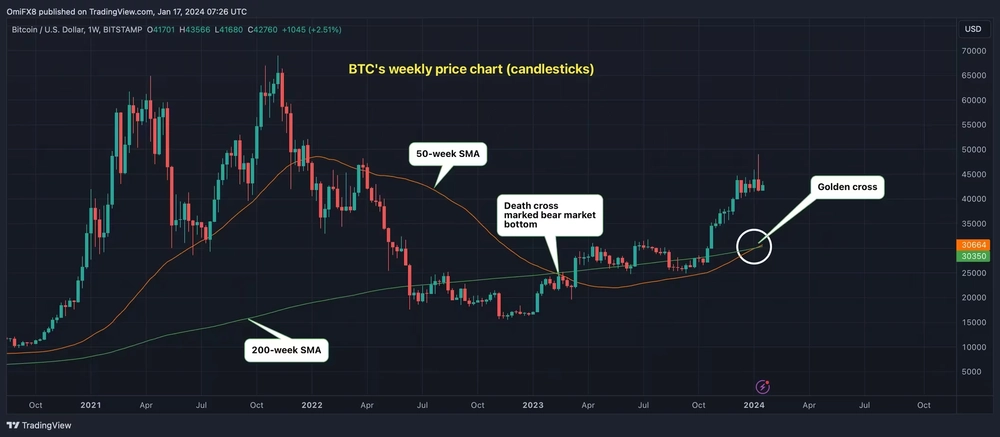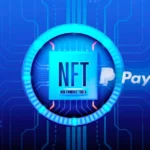In a landmark development for the cryptocurrency market, Bitcoin has witnessed its first-ever weekly “golden cross” on January 17, 2024. This technical indicator, often touted as a predictor of long-term bullish trends, has emerged amidst Bitcoin’s recent rally, raising hopes among investors for a sustained bull market.
Understanding the Golden Cross and Its Significance
The golden cross, a concept borrowed from technical analysis, occurs when the 50-day simple moving average (SMA) of an asset’s price crosses above its 200-day SMA. This crossover is considered a bullish signal, suggesting that the short-term trend is outpacing the long-term trend, indicating a potential shift towards upward price movement.
In the context of Bitcoin, the golden cross marks a significant milestone, as it has never appeared on the weekly chart before. This could be interpreted as a sign of growing investor confidence in Bitcoin’s long-term prospects, particularly after its recent resurgence from the bear market of 2023.
Factors Fueling Bitcoin’s Bullish Momentum
The golden cross is not the sole factor driving Bitcoin’s bullish momentum. Several underlying trends have contributed to this recent surge in price:
- Institutional Adoption: Major institutional investors, including asset managers, hedge funds, and banks, have been steadily increasing their exposure to Bitcoin, viewing it as a potential diversifier to their portfolios and a hedge against inflation.
- Growing Regulatory Clarity: The regulatory landscape surrounding cryptocurrencies has become more favorable in recent years, with several countries adopting supportive measures, such as tax breaks and regulatory frameworks. This regulatory clarity has instilled confidence among investors and institutions.
- Technological Advancements: The Bitcoin ecosystem continues to evolve, with advancements in scaling solutions, such as the Lightning Network, improving transaction efficiency and reducing fees. These improvements make Bitcoin more attractive for everyday use and adoption.
Also read: Best Cryptocurrencies for Trading in 2024
Implications of the Golden Cross and Future Outlook
The golden cross has historically been associated with periods of strong bullish sentiment and price appreciation for various assets, including stocks and commodities. While it is not a guarantee of future price movements, it can serve as a valuable indicator of underlying market trends.
In the case of Bitcoin, the golden cross could signal the beginning of a sustained bull market. However, it is important to note that technical indicators should be interpreted in conjunction with other factors, such as fundamental analysis and overall market sentiment.
Navigating the Crypto Market with Caution
While the golden cross and the overall bullish sentiment surrounding Bitcoin are encouraging, it is essential for investors to exercise caution and carefully consider their risk tolerance. The cryptocurrency market remains volatile, and past performance is not necessarily indicative of future results.
Investors should thoroughly research their investment choices, diversifying their portfolios across various asset classes to mitigate risk. Moreover, they should establish clear investment goals and time horizons, ensuring that their investments align with their financial objectives.
Conclusion
The golden cross in Bitcoin’s weekly chart is a significant development, reinforcing the growing bullish sentiment surrounding the cryptocurrency. However, investors should approach this event with caution and consider it within the broader context of the market. By exercising due diligence and understanding the risks involved, investors can make informed decisions and navigate the dynamic cryptocurrency landscape prudently.
A golden cross is a technical indicator used to assess the trend direction of an asset’s price. It occurs when the 50-day simple moving average (SMA) of an asset’s price crosses above its 200-day SMA. This crossover is considered a bullish indicator, suggesting that the short-term trend is outpacing the long-term trend, indicating a potential shift towards upward price movement.
The golden cross is considered a reliable predictor of long-term bullish trends in various asset classes, including stocks and commodities. Bitcoin is no exception, and its first-ever weekly golden cross is a landmark event, suggesting that the cryptocurrency may be entering a prolonged bull market.
Several factors could be contributing to Bitcoin’s recent rally and the formation of the golden cross:
Institutional adoption: Major institutional investors are increasingly investing in Bitcoin, viewing it as a potential diversifier to their portfolios and a hedge against inflation. This influx of capital is boosting Bitcoin’s price.
Regulatory clarity: The regulatory landscape surrounding cryptocurrencies is becoming more favorable, with several countries adopting supportive measures. This regulatory clarity is increasing investor confidence in Bitcoin.
Technological advancements: The Bitcoin ecosystem is constantly evolving, with advancements in scaling solutions and transaction efficiency improving its usability and attractiveness to investors.
Strong fundamentals: Bitcoin remains a decentralized, secure, and censorship-resistant digital asset with a limited supply, making it a compelling investment for many.
Historical trends: Bitcoin has historically exhibited strong positive correlations with the golden cross formation, suggesting that it may be a reliable predictor of long-term price movements.
The golden cross is a positive indicator, but it is not a guarantee of future price movements. Investors should approach this event with caution and consider it within the broader context of the market. They should carefully research their investment choices, diversify their portfolios across various asset classes to mitigate risk, and establish clear investment goals and time horizons.













